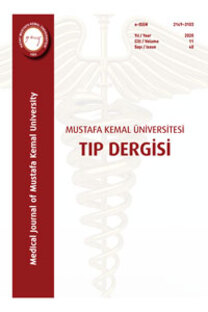OBEZ ÇOCUKLARDA BEYNİN DİFÜZYON AĞIRLIKLI MANYETİK REZONANS GÖRÜNTÜLEME BULGULARI
beyin, çocuk, obezite, difüzyon ağırlıklı manyetik rezonans görüntüleme
Diffusion weighted magnetic resonance imaging findings of the brain in obese children
brain, child, obesity, diffusion weighted magnetic resonance imaging,
___
- Cinaz P. Obezite patogenezinde endokrinolojik mekanizma. V. Ulusal Pediartik Endokrinoloji
- Kongresi. 9-11 Ekim İstanbul 2000; 59-63.
- Raine JE, Donaldson MDC , Gregory JW, Savage MO. Obesity. In: Raine JE, Donaldson MDC ,
- Gregory JW, Savage MO (eds), Practical endocrinology and diabetes in children , United
- Kingdom: Blackwell Science 2001: 161-171.
- Güngör N , Arslanian SA. Nutritional Disorders In: Sperling MA (ed), Pediatric Endocrinology 2nd
- ed, Philadephia: 2002; 689-725.
- Lustig RH. The neuroendocrinology of childhood obesity Pediatr Clin North Am
- ; 48: 909-930.
- Sinha S, Lucas-Quesada FA, Sinha U, DeBruhl N, Bassett LW. In vivo diffusion-weighted MRI of
- the breast: potential for lesion characterization. J Magn Reson Imaging 2002; 15: 693-704.
- Chan JH, Tsuı EYK, Luk SH, Fung SL, Cheung YK, Chan MSM, Yuen MK, Mak SF, Wang KP, et
- all. MR diffusion weighted imaging of kidney: differentiation between hydronephrosis and
- pyonephrosis. Clin Imaging. 2001; 25(2): 110-113.
- Alkan A, Sahin I, Keskin L, Cikim AS, Karakas HM, Sigirci A, Erdem G. Diffusion-weighted
- imaging features of brain in obesity.Magn Reson Imaging. 2008; 26(4): 446-450.
- Holsen LM, Zarcone JR, Thompson TI, Brooks WM, Anderson MF, Ahluwalia JS, et al. Neural
- mechanisms underlying food motivation in children and adolescents. Neuroimage 2005; 27(3): 669–
- -
- Stookey JD, Barclay D, Arieff A, Popkin BM. The altered fluid distribution in obesity may reflect
- plasma hypertonicity. Eur J Clin Nutr 2007; 61(2): 190–199.
- Cole TJ, Bellizzi MC, Flegal KM, Dietz WH. Establishing a standard definition for child overweight
- and obesity worldwide: international survey. BMJ 2000; 320: 1240-1243.
- Moritani T, Shrier DA, Numaguchi Y, Takase Y, Takahashi C, Wang HZ, et al. Diffusion-weighted
- echo-planar MR imaging: clinical applications and pitfalls, a pictorial essay. Clin Imaging 2000;
- (4):181-92.
- Van Marken Lichtenbelt WD, Fogelholm M. Increased extracellular water compartment, relative to
- intracellular water compartment, after weight reduction. J Appl Physiol 1999; 87: 294–298.
- ISSN: 2149-3103
- Yayın Aralığı: 3
- Başlangıç: 2010
- Yayıncı: Hatay Mustafa Kemal Üniversitesi Tıp Fakültesi Dekanlığı
OBEZ ÇOCUKLARDA BEYNİN DİFÜZYON AĞIRLIKLI MANYETİK REZONANS GÖRÜNTÜLEME BULGULARI
Gülen BURAKGAZİ, Tülin ÖZTÜRK, Muammer AKYOL, Hanefi YILDIRIM
HER İKİ KALÇADA AYNI ANDA GELİŞEN İDYOPATİK BİLATERAL AVASKÜLER NEKROZ: OLGU SUNUMU
Abdullah YAĞIZ, Nilgün ÜSTÜN, Hayal GÜLER, Ayşe TURHANOĞLU
MYASTENİA GRAVİSLİ BİR HASTADA SPİNAL ANESTEZİ YAKLAŞIMIMIZ
Onur KOYUNCU, Selim TURHANOĞLU, Çağla AKKURT, Kasım Tuzcu, İbrahim YETİM, Mustafa UĞUR
